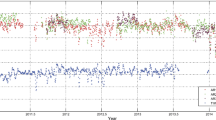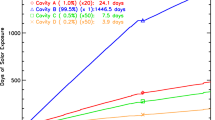Abstract
A comparative analysis of measurements of total solar flux in the active cavity radiometer irradiance monitor (ACRIM) and Physikalisch-Meteorologisches Observatorium Davos (PMOD) scales was performed. An analysis of integrated differences of simultaneous measurements of solar flux made it possible to estimate the systematic differences that can lead to the accumulation large errors with time. The measurements of solar flux in ACRIM and PMOD scales were reduced to an intermediate radiometric scale through data correction for systematic errors. The corrected measurements in the unified scale were consistent and there is a compromise between initial data sets. The measurements in the intermediate scale indicate changes in solar flux between the minima of solar activity in 1986, 1996, and 2008. The amplitude of these variations is comparable with uncertainty in their long-term trends, which questions earlier obtained estimates for secular variations of solar luminosity.
Similar content being viewed by others
References
Abdusamatov, Kh.I., On a Change in the Solar Irradiance and a Decrease in the Earth Global Temperature to the State of Deep Cooling in the Middle of the 21th Century, Izv. Krym. Astrofiz. Obs., 2007, vol. 103, pp. 292–298.
Dewitte, S., Crommelynck, D., Mekaoui, S., and Joukoff, A., Measurement and Uncertainty of Long Term Total Solar Irradiance Trend, Sol. Phys., 2004, vol. 224, pp. 209–216.
Foukal, P. and Lean, J.L., Magnetic Modulation of Solar Luminosity by Photospheric Activity, Astrophys. J., 1988, vol. 328, pp. 347–357.
Foukal, P., Frohlich, C., Spruit, H., and Wigley, T.M.L., Variations in Solar Luminosity and Their Effect on the Earth’s Climate, Nature, 2006, vol. 443, pp. 161–166.
Fröhlich, C., Evidence of a Long-Term Trend in Total Solar Irradiance, Astron. Astrophys., 2009, vol. 501, pp. L27–L30.
Fröhlich, C., Solar Irradiance Variability Since 1978, Space Sci. Rev., 2006. vol. 125, no. 1–4, pp. 53–65.
Fröhlich, C. and Lean, J., The Sun’s Total Irradiance: Cycles and Trends in the Past Two Decades and Associated Climate Change Uncertainties, Geophys. Res. Lett., 1998, vol. 25, pp. 4377–4380.
Kitchatinov, L.L., Mordvinov, A.V., and Pipin, V.V., Variations in Solar Luminosity in the 11-Year Cycle: Observations, Physics, Models, Soln.-Zemn. Fiz., 2002, no. 2, pp. 3–6.
Kopp, G., Lawrence, G., and Rottman, G., The Total Irradiance Monitor (TIM): Science Results, Sol. Phys., 2005, vol. 230, pp. 129–139.
Mekaoui, S. and Dewitte, S., Total Solar Irradiance Measurement and Modelling during Cycle 23, Sol. Phys., 2008, vol. 247, pp. 203–216.
Mordvinov, A.V. and Willson, R.C., Effect of Large-Scale Magnetic Fields on Total Solar Irradiance, Sol. Phys., 2003, vol. 215, pp. 5–16.
Mordvinov, A.V., Long-Term Variations in the Integral Solar Irradiance and Errors in Their Estimates, Tr. konf. “Solnechnaya i solnechno-zemnaya fizika-2008” (Proc. Conf. “Solar and Solar-Terrestrial Physics-2008”), St. Petersburg, 2008, pp. 247–250.
Mordvinov, A.V., Makarenko, N.G., Ogurtsov, M.G., and Jungner, H., Reconstruction of Magnetic Activity of the Sun and Changes in Its Irradiance on a Millennium Timescale Using Neu-Recomputing, Sol. Phys., 2004, vol. 224, pp. 247–253.
Solanki, S.K. and Fligge, M., A Reconstruction of Total Solar Irradiance since 1700, Geophys. Res. Lett., 1999, vol. 26, pp. 2465–2468.
Wang, Y.-M., Lean, J.L., and Sheeley, N.R., Modeling the Sun’s Magnetic Field and Irradiance since 1713, Astrophys. J., 2005, vol. 625, pp. 522–538.
Wenzler, T., Solanki, S.K., Krivova, N.A., and Fröhlich, C., Reconstruction of Solar Irradiance Variations in Cycles 21–23 Based on Surface Magnetic Fields, Astron. Astrophys., 2006, vol. 460, pp. 583–595.
Willson, R.C. and Hudson, H.S., The Sun’s Luminosity over a Complete Solar Cycle, Nature, 1991, vol. 351, pp. 42–44.
Willson, R.C. and Mordvinov, A.V., Secular Total Solar Irradiance Trend during Solar Cycles 21–23, Geophys. Res. Lett., 2003, vol. 30, pp. 1199–1202.
Willson, R.C., http://www.acrim.com.
Willson, R.C., Gulkis, S., Janssen, M., et al., Observations of Solar Irradiance Variability, Science, 1981, vol. 211, pp. 700–702.
Willson, R.C., Total Solar Irradiance Trend during Solar Cycle 21 and 22, Science, 1997, vol. 277, pp. 1963–1965.
Author information
Authors and Affiliations
Additional information
Original Russian Text © A.V. Mordvinov, 2010, published in Solnechno-Zemnaya Fizika, 2010, Vol. 15, pp. 9–12.
Rights and permissions
About this article
Cite this article
Mordvinov, A.V. Reduction of measurements of total solar flux to a unified scale and uncertainty in estimating its long-term trends. Geomagn. Aeron. 50, 933–936 (2010). https://doi.org/10.1134/S0016793210080025
Published:
Issue Date:
DOI: https://doi.org/10.1134/S0016793210080025




